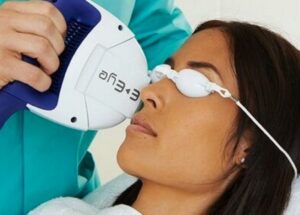What is Dry Eye Disease?
Dry eye disease is caused by an ongoing lack of sufficient lubrication and moisture on the surface of the eye.
Dry eye can cause a scratchy sensation or the feeling that something is in the eye, with people often complaining of irritated, itchy, watery eyes.
Dry eye disease is fairly common affecting about 30 per cent of the population and is more prevalent in an older population and in particular with females.
Meibomian Gland dysfunction (MGD) is the leading cause of dry eye disease where the eye lid glands are not secreting enough oil or when the oil they secrete is of poor quality. Meibomian glands are located inside the bottom eyelids and are responsible for the creation of a tear film that keeps eyes moisturised and prevents evaporation of tears.
What are the Symptoms and Causes of Dry Eye Disease?
Some of the symptoms of dry eye disease include some or all of the following:
- Scratchy sensation or a feeling that something is in the eye
- Stinging or burning
- Episodes of excess tearing that follow periods of dryness, discharge, pain and redness in the eye
- Itchiness
- Dryness
- Eye fatigue
- Feeling that the eyelids are heavy
- Experiencing blurred vision.

Factors that can contribute to dry eye include:
- A range of medications including antihistamines, decongestants, antidepressants, birth control pills, hormone replacement therapy to relieve symptoms of menopause, medications for anxiety, Parkinson’s disease, and high blood pressure have been associated with dry eye disease.
- Ageing: Dry eye is more common in people aged 50 years or older.
- Rosacea (an inflammatory skin disease) and blepharitis (an inflammatory eyelid disease).
- Autoimmune disorders such as Sjögren’s Disease, lupus, scleroderma, and rheumatoid arthritis and other disorders such as diabetes, thyroid disorders, and Vitamin A deficiency are associated with dry eye.
- Hormonal changes during pregnancy and after menopause have been linked with dry eye. Women also have an increased risk for autoimmune disorders.
- Windy, smoky or dry environments increase tear evaporation.
- Seasonal allergies can contribute to dry eyes.
- Prolonged periods of digital screen time encourage insufficient blinking which can be a contributing factor.
- Laser eye surgery may cause temporary dry eye symptoms.
Eyes that have poor lubrication are more susceptible to scratches or infection. Tears keep the eye surface smooth and protected. A lack of lubrication can lead to excessive rubbing of the eyes when they are itchy which can exacerbate the irritation.
Your vision can be affected as tears on the eye’s surface can play an important role in focusing light. In some cases, deeper injuries to the surface of the eye can lead to corneal scarring, resulting in a hazy cornea and impaired vision.
Dry Eye Treatment
A range of dry eye treatments are available including:
- Artificial eye drops often provide short-term relief along with the application of a warm compress to help loosen any blockages in the oil glands.
- Blephasteam is an eyelid warming device using moisture and heat to treat Meibomian gland dysfunction. The treatment sessions are short and work well for most people with Meibomian gland dysfunction.
- Intense Pulsed Light (IPL) can provide long-term relief.
View Blog Article about New Dry Eye Solutions:

New Dry Eye Solutions
New Long Term Solutions To Dry Eye
There have been recent significant advances in the successful long term treatment of people who suffer from chronic dry eye.




